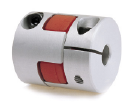THE ABCs OF MOTION COUPLINGS

What are couplings?
In the simplest of terms, couplings are mechanical devices used to connect two rotating shafts in order to transmit torque and position. Couplings generally fall under one of two basic categories, 1) Power Transmission couplings for connecting shafts in machines such as generators, compressors, motors, and pumps, and 2) Motion Control couplings used to connect servo motors, step motors and encoders in machines that typically demand higher speed, performance and accuracy. Most couplings, regardless of category, improve machine reliability by accommodating misalignment(s). If selected and installed properly, couplings will help protect machine components from premature failure, increasing productivity.
Why are couplings necessary?
Misalignments are inevitable within machines and are caused by a number of factors including tolerance errors, installation errors, machine age and run-time. These misalignments can affect productivity, and the bottom line, by increasing wear and tear and causing pre-mature failure and possible damage to other machine parts. Downtime and damaged parts lead to higher and higher maintenance costs and lower productivity, a bad combination for business. Flexible shaft couplings can help absorb these unavoidable misalignments, saving time and money for both end users and machine builders. This is especially true of Motion Control couplings that are often required to accelerate, decelerate, stop, start and reverse while transmitting torque and position.
Types of misalignment
Misalignments can fall into three categories. Angular misalignment is caused by bending. Axial misalignment is a compression or expansion of the coupling, typically caused by variations and temperature (Thermal expansion), inside the machine. Parallel misalignment is the result of the two shafts being coupled experiencing shear displacement. Many applications include more than one type of misalignment, the right coupling can help protect a machine from a combination of these misalignments.

What kinds of Motion Control couplings are there?
Using the right kind of coupling can spell the difference between a machine running smoothly and one that requires constant maintenance. Motion Control couplings can be broken down into the following categories, all precision, zero-backlash couplings:
 |
1. Beam——A Beam coupling is more or less a large mechanical spring. It is made from a single piece of aluminum or stainless steel with spiral or parallel cuts to handle angular and parallel misalignments while transmitting torque in a low cost, low inertia design. |
 |
2. Bellows—Bellows couplings are comprised of multiple convolutions of metal that provide the benefit of high torsional stiffness, ideal for positioning applications, while still accommodating angular misalignment in a low inertia design. |
 |
3. Jaw—Jaw couplings can either be straight or curved and consist of interlaced metal jaws that mate around an elastomer insert or “spider.” The spider can dampen vibration, provide electrical isolation while also accommodating angular misalignment. Jaw couplings are an economical solution for handling a variety of motion applications that are continuous with light to moderate cycle duty. |
 |
4. Disc—Disc couplings are designed with two aluminum or steel hubs and stainless steel plate springs or disc packs that transmit torque while accommodating angular misalignment. Disc couplings are commonly used in servo applications that require low inertia, high torsional stiffness, and repeatable bi-directional characteristics. |
 |
5. Encoder—Encoder couplings protect feedback devices and encoders from misalignment while also providing electrical isolation. They are not designed for torque transmission. |
 |
6. Oldham—Oldham couplings are perfect for accommodating high amounts of parallel misalignment and axial misalignment. Consisting of two, toothed hubs, that mate with an elastomer insert, if the insert fails there is no contact between hubs so the Oldham coupling is like a mechanical fuse. Oldham couplings are excellent for systems that face large thermal expansions and contractions throughout the day |
 |
7. Rigid—Rigid couplings are one-piece aluminum or stainless steel couplings that feature a low cost, low inertia design for high-response motion applications. They can transfer torque with a high level of accuracy, but their rigidity makes them almost incapable of absorbing any type of misalignment. |
*All couplings described above are zero-backlash Motion couplings designed to transmit torque while providing positional accuracy.
Couplings can greatly reduce machine wear and tear and keep maintenance costs down. Knowing which type of coupling design and performance characteristics can handle which type of misalignment, and other application requirements, can save time and money in the long run. If a coupling saves time and money, it is impacting productivity and improving your bottom line.
Making the right coupling connection for your needs has never been easier. Candy Controls is here to help with our innovative line of high performance, zero-backlash Motion Control couplings. Call or email today to discuss your next coupling application.
 Candy Controls
Candy Controls